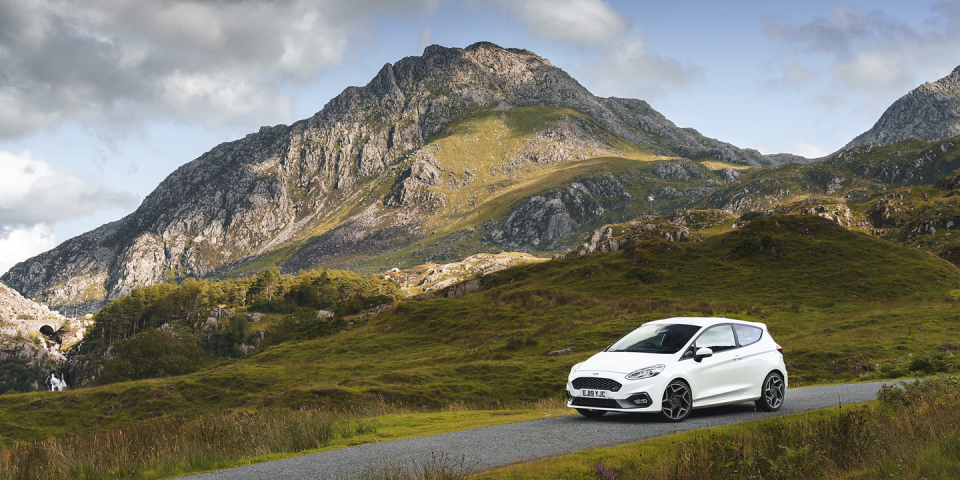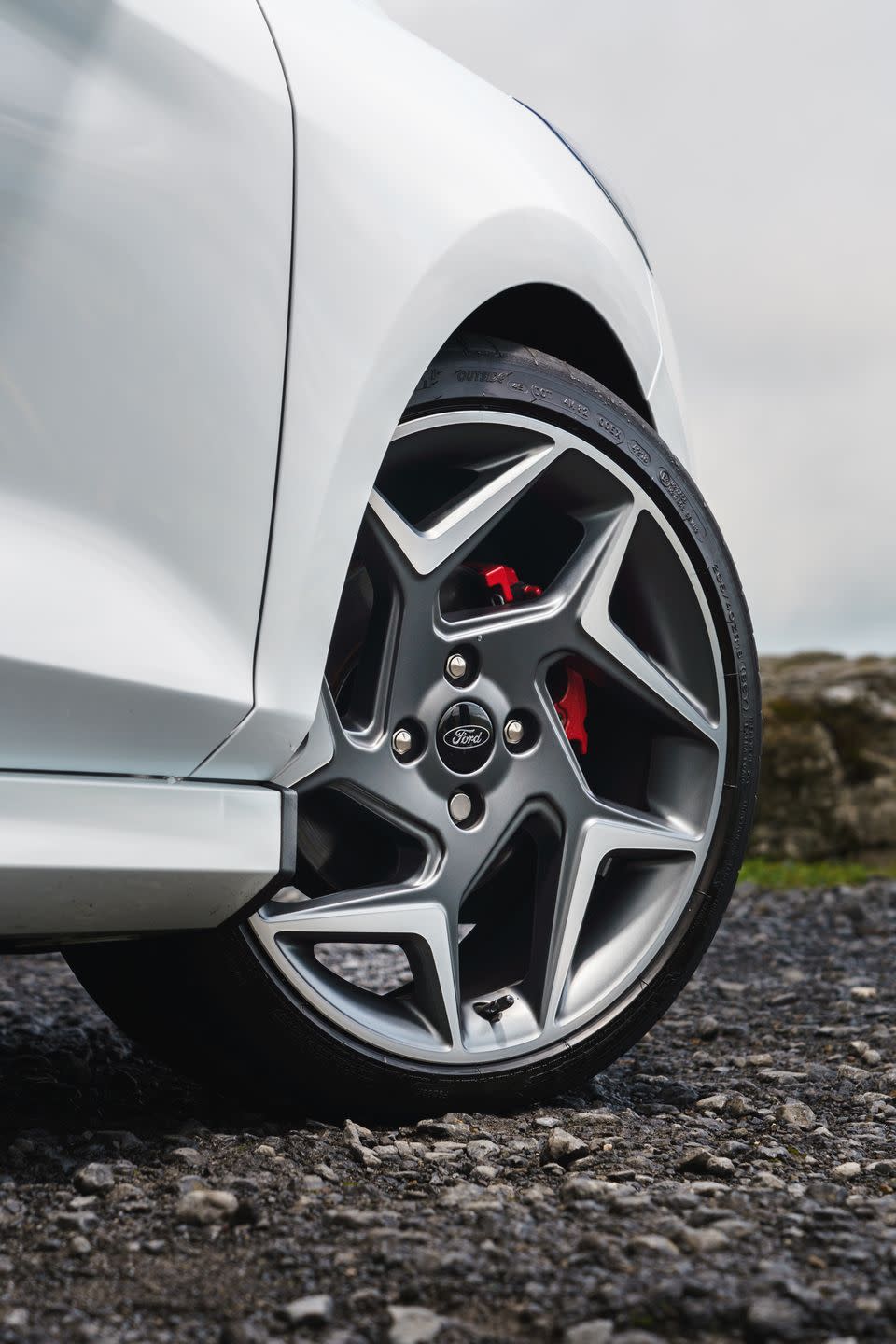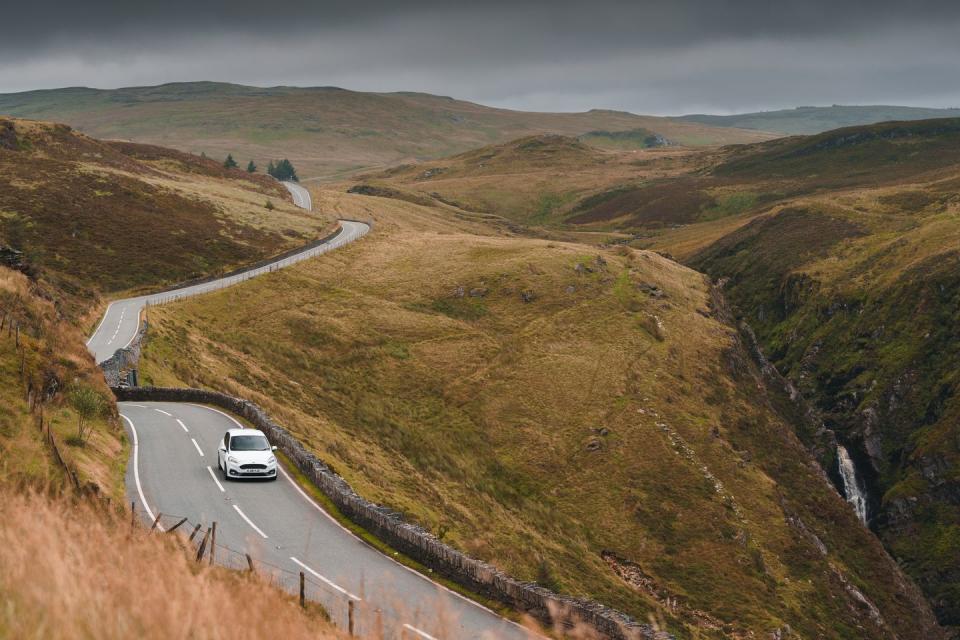The New Fiesta ST Is the Best Ford You Can’t Buy

I wanted to make the new Fiesta ST look like it was on a rally stage. Ford has had a consistent presence in British rallying for decades, so leaping the car over the crest of a moss-covered hill felt right. And in Wales, a country with roads so narrow that most Americans wouldn't immediately recognize them as having two lanes—creating that picture wasn't difficult.
Wales being Wales though, it rained. The small mountainous country bordering England spends most of the year damp, and the higher you climb into the mountains, the more likely you are to get wet. In any other car, I would've driven tentatively. But the Fiesta ST does not encourage rationality. It wants to be thrashed.
We went to Wales for two reasons. First, it's the best place in the world to drive a hot hatch like the ST. Second, it's a place you can find the Fiesta ST, because Ford no longer sells the car in the United States. Last spring, the company announced its plan to kill off the majority of its North American passenger-car lineup, refocusing on more profitable crossovers and trucks. From a business perspective, that makes sense, at least in the short term. Nevertheless, it feels odd. Absent cars, is Ford—the company that put America on wheels—really Ford?

In a land of wide, straight roads and cheap gas, the Fiesta was an odd fit. The model arrived in the United States in 2010, on the tail of the 2008 financial crisis. Conventional wisdom then suggested that the economic downturn and rising gas prices would send consumers after smaller, more efficient vehicles. The Fiesta fit the brief, and it was also one of Ford's most involving and satisfying enthusiast cars—great chassis, willing engine, piles of feedback. The ST, which arrived in 2014, elevated those bones. It was a benchmark for front-wheel-drive handling, at a base price around $21,000. Dollar for dollar, there wasn't a better enthusiast car on the market.

Most Americans didn't care. Ford sold fewer than 540,000 Fiestas in this country between the model's launch and July of 2019. The brand sold more than 900,000 F-150s here last year alone. Even the ST, which eschewed big numbers for real-world fun, really only appealed to enthusiast diehards.
The new ST, introduced in Europe in 2018, is a lot like the old one. It uses a revised version of the old Fiesta platform with a slightly wider track and longer wheelbase, but overall dimensions are nearly identical. You still sit behind a deep dash and laid-back windshield, looking at a hood that falls away sharply, like a van's. There's still a twist-beam axle out back, though it now uses what Ford calls Force Vectoring springs. These springs are directionally wound as to minimize lateral axle compliance—a cheap, relatively light solution that allows for soft bushings and greater ride comfort but also sharp handling. Brake-actuated torque vectoring, super-quick steering, and a Quaife limited-slip differential (part of an optional Performance Pack) help the car dive into corners and snap out of them.
All good stuff, but nothing radical. The real change lies under the hood. The 1.5- liter three-cylinder matches the 197 hp of the old ST's four, and its 214 lb-ft of torque out-twists the previous engine by 11 lb-ft. It's only available with a six-speed manual and managed by three drive modes that also change steering weight and stability-control intervention. Our three-door, Performance Pack-equipped tester stickered for £23,325 (about $28,600 at press time).
Early in our drive, R&T photographer and Englishman Dean Smith, perhaps cranky from standing in the cold rain, wondered why we traveled all the way to Wales to test this particular car. He had a point: the country isn't exactly a tropical paradise, and in Great Britain, the Fiesta is basically an appliance, England's best-selling car. But the choice was appropriate. The British view Ford as a domestic brand—the marque has been building cars in Great Britain since 1911, and it has a long history of designing vehicles specifically for this market. Fuel is expensive, parking spaces are small, and wheeling anything even remotely large through a small village is a chore. The Fiesta just plain works here, and when you leave the towns for the wide expanses where the twisting, undulating road appears painted on the landscape, the ST feels perfect.
For me, though, that love took time. The driving position is odd, and there's noticeable tire noise at highway speed. Wind noise is relatively low for a car in this category, though, and the three-pot—which can operate almost imperceptibly as a parallel-twin via a mechanism that quietly disconnects the valvetrain on one cylinder—gets great fuel economy. The biggest issue is ride quality. Ford took flak both stateside and abroad for making the last Fiesta ST almost irritatingly stiff, and it initially seemed as if our test car was more of the same. Leaving London and heading west on the M4 expressway, I found myself wondering if the ST was tuned more for the smooth roads near the German factory where the car is built.
All worry subsided in the Brecon Beacons. It's one of Wales' three national parks, with roads winding through and over a county's worth of verdant mountains and hills. And where the sheep are especially dumb"they'll just walk straight into the road here," Smith warned. Even the park's largest roads can be challenging, with hairpins tight enough to lift a rear wheel. But while the ST is definitely stiff, its damping is unimpeachable. The car doesn't offer gobs of suspension travel, but it still manages to keep at least three of its Michelin Pilot Super Sports on the ground.

Those tires are excellent, the grippy sort of rubber usually found on Corvettes and BMW M3s. The Michelins have so much stick that they rob the Ford of a little low-speed, lift-off oversteer—stuff that's usually fun in a slower front-drive car—but they give the Fiesta right-now response, and the driver tons of confidence. As in most modern supercars, the steering is quick, a little over two turns lock-to-lock. Unlike most modern supercars, the ST's steering has actual feel and natural weight.
There's a fine line between "this car is confidence-inspiring" and "this car has possessed me with a demon spirit and the inexorable urge to drive flat out all the time." I crossed that line in the Elan Valley, where narrow roads wind high around fabricated reservoirs, and the thickly stacked pine trees make the Brecons look barren by comparison. The rain came down harder and harder, but I couldn't stop pushing. The stiff rear end, the way it rotates off throttle, how you can get on the power early and feel the diff work to slingshot you out of the corner—the ST exudes manic energy.
And the engine lives up to the chassis. Ford went with a three-cylinder not for fuel economy (the difference between three and four cylinders is negligible here) or weight savings (a balance shaft adds back most of the mass saved by ditching one piston), but simply because the engineers thought the three was cool. The engine gives a unique, muted wait-is-that-a-six-cylinder? growl, and there doesn't seem to be any sacrifice for dropping a cylinder. Throttle response is excellent, turbo lag is minimal, and the engine pulls hard from 3000 rpm to its 6000-rpm power peak. Ford's claimed 6.5-second 0-60-mph time puts the car a little bit quicker than the old Fiesta ST, but not too fast for its own good. You can use plenty of full throttle without sailing much beyond the speed limit. The driveline's only real drawbacks are a relatively heavy flywheel and programmed rev-hang on shifts—many modern cars do this to aid shift smoothness and emissions, and to minimize wear—and tall first and second gears. The mix can initially add up to a few clumsy shifts, but you get used to it.
If you're lucky in life, you get a handful of drives where road and car are perfectly matched. You want to keep going until you boil the brakes and wear the tread off the tires. If you've never experienced this, get your hands on a Fiesta ST and aim it at Snowdonia National Park in North Wales, where the roads scythe through and over the mountains and the scenery is unlike anywhere else. Where the driving is so good that car-makers, tuners, and suspension manufacturers use these roads to dial in their cars, the way they use the Nürburgring or the Pacific Coast Highway. There is no better place for this sort of work.
It's tempting to call the Fiesta ST analog—the little Ford feels wonderfully, almost anachronistically simple—but it isn't. This is ultimately a modern device, designed to sync with your iPhone, ace crash tests, sip fuel, and not pollute the environment too much. But it feels old-school in spite of this stuff. Modernity doesn't get in the way.

Before I left for Wales, R&T senior editor Zach Bowman, a former Fiesta ST owner, asked me if there was a case for bringing the new car to the U.S. In quieter moments, when the roads straightened out, I thought about it. Americans likely wouldn't welcome this car any more warmly than they did the old one. On paper, it doesn't offer much to most of the population. But we should want this. It does so much with so little. It makes me want to shake the hand of every single American who bought the old ST and thank them for understanding when others didn't. So many modern performance cars prioritize big numbers over fun. Why should numbers matter at all? Why should a performance car be anything but fun? How much power? Who cares! Zero-to-60? Irrelevant!
It's tempting to think that Ford has lost its way. That not selling cars in North America means the company no longer has a soul. That's not the case—you just have to look harder for the good stuff. And the search might lead you across an ocean, to a funny little country with no lack of sheep and seemingly endless wet green hills hiding some of the best roads on earth.

You Might Also Like
